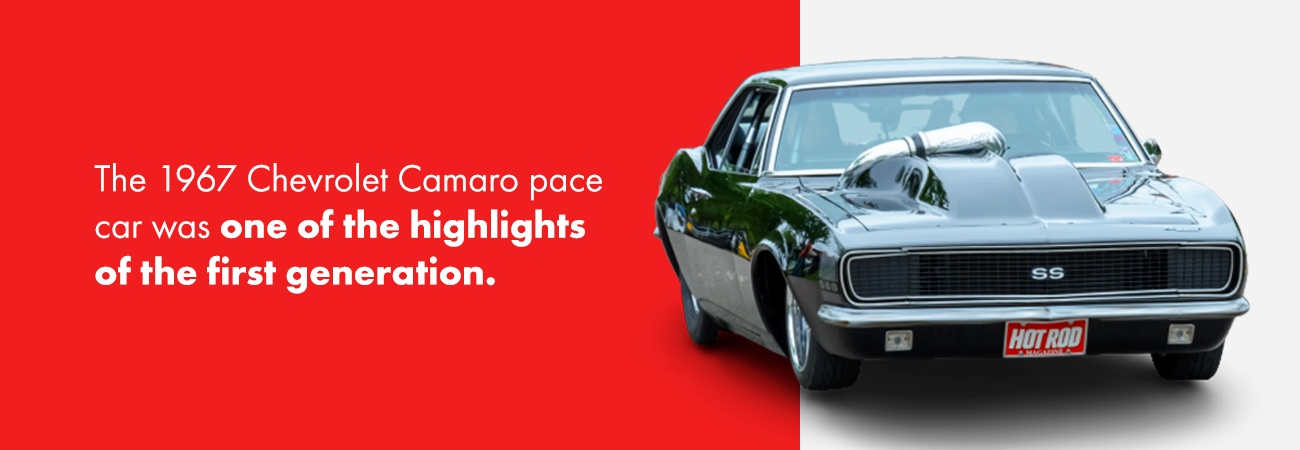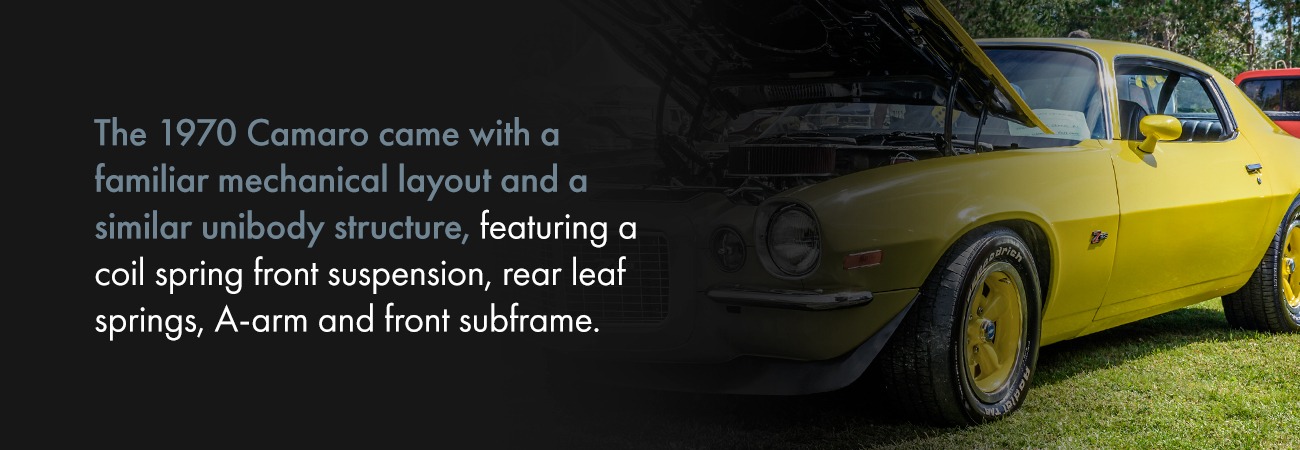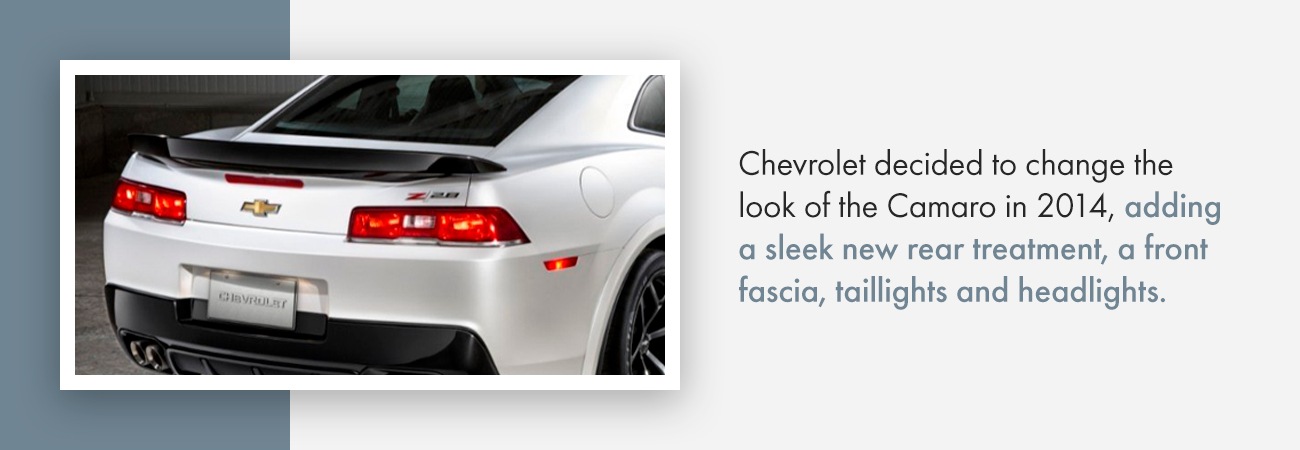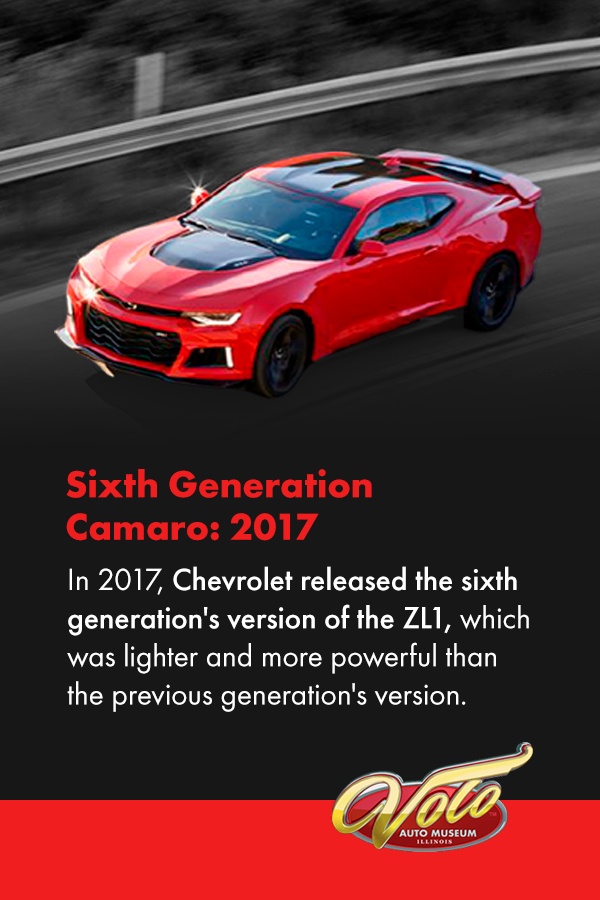
History of the Chevy Camaro | Evolution of the Camaro

The Chevy Camaro is one of the most notable cars in pony and muscle car history. As a direct competitor to the Ford Mustang, the Camaro has persevered throughout the years, earning the respect of automotive enthusiasts. With six generations of Camaros, buyers can find a car that fits their style and performance needs. Any Camaro enthusiast may want to know more about the Camaro's evolution and the main ways it changed since its first release in 1966.
If you love Camaros, learn about the history of the car and how the Camaro evolved over its many generations.
Table of Contents
- First Generation Camaro: 1967 to 1969
- Second Generation Camaro: 1970 to 1981
- Third Generation Camaro: 1982 to 1992
- Fourth Generation Camaro: 1993 to 2002
- Fifth Generation Camaro: 2010 to 2015
- Sixth Generation Camaro: 2016 to 2020
- Camaro FAQs
- Find Your Dream Camaro at Volo

Brief History of the Chevy Camaro
Before the Camaro went into production in the mid-1960s, the Ford Mustang had a dominant position in the pony car market. As a Ford competitor, Chevrolet knew their compact Corvair wouldn't sell well enough to close the gap with Mustang. The press had noted the Corvair had some safety issues, and the car's rear-engine design made it unattractive to many buyers. These issues caused Chevrolet to look for other options.
To compete with the Ford Mustang, Chevrolet designed a pony car featuring a front-engine configuration and a rear-drive, just like the design of their competition's cars. As the car went into development, General Motors' vice president, Ed Rollet, and Chevrolet's merchandise manager, Bob Lund, reportedly came up with the idea for the Camaro's name after reading the word "camaro" in a French-English dictionary.
This French slang word referred to a comrade, friend or pal. While not an official French word, Lund and Rollet loved it, seeing it as the perfect name for a car they wanted its owner to view as a friend. They added their own spin to the word to make their intentions clear, telling the press it also referred to a small animal that ate Mustangs.
With the design and name nailed down, Chevrolet debuted the car in the fall of 1966, offering it to buyers as a 1967 model. The Camaro would go on to serve its purpose, competing with the Mustang throughout its rich history. Currently on its sixth generation, the Camaro has evolved significantly, weathering challenges and offering buyers an exceptional driving experience.
First Generation Camaro: 1967 to 1969
First released in late 1966 as a 1967 model, the first-generation Camaro was the shortest-lived generation, only running until 1969 before Chevrolet shuttered it for the car's next iteration. During its run, it came in a two-door convertible or two-door coupe model, both designed with rear-wheel drive.
As a competitor to the Mustang, the Camaro came in several different editions designed to attract various buyers. Buyers could select from standard, Super Sport (SS) or Rally Sport (RS) models. Alongside the different editions, Chevrolet also sold multiple engine options, with four different small-block V8 options and two big-block V8 engines as well. One of the most common engine options was a 230-cubic-inch engine offering 140 horsepower, and the most powerful engine was a 396-cubic-inch engine featuring 375 horsepower.

In 1967, the car only reached about half of Mustang sales, with around 220,000 Camaros sold compared to close to 480,000 Mustangs sold. However, the car still showed a lot of promise, with some timeless cars produced this year. The 1967 Chevrolet Camaro pace car was one of the highlights of the first generation. This specialty convertible Camaro led the Indianapolis 500 in 1967, with Chevy giving it a custom paint job for the race.
Alongside serving as a pace car, the Camaro also hit the raceway as a competitor. Chevrolet released a 1967 Z/28 for the SCCA Trans-Am racing series, putting it in the hands of Mark Donohue. They outfitted the Camaro with a 4.9-liter high-compression V8 engine that hit 290 horsepower. To improve its racing ability, the engineering team gave the body shell an acid bath. This car would prove successful on the track, with Donohue winning three times in 1967 and 10 out of 13 times in 1968.

In 1968, Chevrolet released their 1968 Camaro, giving a makeover to the 1967 models. Chevy removed vent windows from this model and gave it a fresh air-inlet system called Astro Ventilation in their place. Additionally, they gave the vehicles new divided rear taillights and front pointed grilles. The car also featured oval front running lights, replacing the circular lights of the past. Performance-wise, Chevrolet gave higher-performance models multi-leaf rear springs and revised the Camaro's rear shock absorbers to help with wheel hop.
If buyers selected the SS package for this year, they received a revised suspension, black accents on the grille, dual exhaust, an option for a new big block engine and red-stripe tires. Additionally, the RS options came with sleek hidden headlights. Chevy continued to produce racing cars, with a 1968 Chevrolet Camaro Pro Stock competing in National Hot Rod Association (NHRA) drag racing.
In 1969, Chevrolet decided to give the Camaro a fresh, sporty look. While the car had similar mechanical components and the same drivetrain from 1968, Chevrolet changed the exterior by adding new sheet metal to everything but the trunk lid and hood. Designers gave the car deeper headlights and a heavy V cant grille. Additionally, Chevrolet's changes to the rear valance panel, rear quarter panels and door skins made the car wider and lower.
The 1969 Z11 convertible Camaro paced the Indianapolis 500, increasing the profile of the car once again. The car was popular enough that Chevrolet made thousands of replicas of it, offering them in the orange houndstooth upholstery unique to the pace car. Additionally, these cars came with SS and RS packages, giving drivers all of the bells and whistles they could ever want.
Though GM forbid Chevrolet from placing any engines larger than 400 cubic-inch in their smaller and mid-size models, some dealers got around this dictate with a specialty ordering process. By using Central Office Production Orders (COPO), dealers could offer two models with engines over 400 cubic-inches.
Chevrolet produced a COPO 9561 with an L72 big-block engine that produced 460 pound-feet of torque and 425 horsepower. The company sold these Camaros in a limited number, with only 1,000 of them featuring the L72 engine. The COPO 9560 featured a 427 cubic-inch engine with 430 horsepower designed for drag racing and dubbed the ZL-1. Since Chevy only produced 69 Camaros outfitted with the ZL-1, it's a rare model. If you want speed and power, the COPO models are for you.

Second Generation Camaro: 1970 to 1981
With a successful first-generation run, Chevrolet looked to improve on the Camaro in its second generation. This Camaro came with a familiar mechanical layout and a similar unibody structure, featuring a coil spring front suspension, rear leaf springs, A-arm and front subframe. Though the second-generation Camara was similar to the first, Chevy made several refinements to the vehicle over its 11-year run.
In February 1970, Chevrolet shipped their second-generation models to dealers, finally making them available to consumers. These Camaros were larger than the first generations, and Chevy only offered them as coupes, without any convertibles available. Additionally, the 1970 Camaro had most of the same drivetrains from the previous generation available except for the 230 cubic-inch six-cylinder engine. Chevrolet outfitted the base offerings for the Camaro with a 250 cubic-engine, featuring 155 horsepower.
In terms of body style, the Camaro arrived without any rear-side quarter windows but came with ventless full-door glass and a fastback roofline. Chevrolet replaced their older roof with a new one offering better noise reduction and rollover protection. Additionally, the 1970 Camaro had wider doors, so it was easier to reach the rear passenger seats. Chevy outfitted the car with a horizontal crease on the side and round taillights. Those who purchased the RS package also received a Camaro with a distinctive split-bumper design.
Though the 1970 model was the first of the second generation, it offered the most horsepower of all of the following second-gen models. Buyers could select an SS package with a 450 horsepower engine or other packages with a big block engine with 375 horsepower, among other high-power engines.
Starting in 1971, GM ordered that all engines should run on a specific kind of gasoline, leading to lower compression rates. As a result, engine power dropped significantly during 1971. In 1972, more federal safety and emissions regulations meant Chevrolet had to make more changes to the Camaro, slashing their engines' horsepower significantly and revising the bumper. Though GM almost dropped the car due to new federal regulations, the Camaro's popularity won out, leading them to believe the car would still sell.
In 1973, Chevy continued to improve on the vehicle's safety, adding a front bumper system designed to absorb impacts of up to 5 miles per hour. They also dropped the SS package and cut one of the V8 engines from the lineup. Though power continued to decrease, Chevrolet offered a revised V8 engine that supported air-conditioning. Additionally, they made some smaller changes, like an optional power window and a standard automatic transmission shifter mounted on the console.
1974 saw Chevrolet make some of the biggest cosmetic changes to the vehicle. The company added a forward-sloping grille and an aluminum bumper, increasing the Camaro's length by 7 inches. The Camaro also received new rectangular, wraparound taillights. After this year, Chevy replaced the thick roof pillars and flat rear windows with a wraparound rear window and slim roof pillars.
Chevrolet made some mechanical changes to the Camaro in 1975, including a catalytic converter for all exhaust systems. This converter featured a more efficient emission control system, helping to decrease the Camaro's overall emissions. With greater emission control, the Camaro's engines saw improved fuel economy and drivability. They also added GM High Energy electric ignitions to Camaros, which extended maintenance intervals for spark plugs and oil changes.
Buyers could no longer purchase a Z/28 option in 1975, as Camaro dropped it despite its promising sales the year before. Two 350 cubic-inch engines were available, which produced either 145 horsepower or 155 horsepower. This significant drop in horsepower from the 1970 model was largely consistent with the rest of the auto industry, as companies adjusted to federal emissions regulations. Even without the Z/28 package and horsepower options only going up to the mid 100s, the car still sold well.
In 1977, the Z28 returned without the slash in the middle of its name. This new Z28 came with a more powerful V8 engine than other previous models, clocking in at 185 horsepower. For base models, the V8 engine offered only 145 horsepower. While there weren't many other notable changes during this year, the Camaro outsold the Mustang for the time in its history, beating the Mustang by 65,000 units.

1978 was another major year for cosmetic changes, as Chevrolet added body-colored urethane rear and front bumpers to the Camaro. Additionally, the Z28 option from this year continued to make its come back. This package included a new non-functioning hood scoop and amber-colored taillight turn signals. Buyers could also select Rally Sport, Type LT and Sports Coupe models during this year.
A new luxury Berlinetta model was the big highlight of 1979. This new model replaced the older Type LT, coming with flatter instrument panels. The Z28 also received new fender flares and a front spoiler. In 1980, Chevrolet offered a couple of new engines for various Camaro packages, and every package received an 85 mile-per-hour speedometer due to federal regulations. The 1981 model closed out the second generation without any major changes to the Camaro.

Third Generation Camaro: 1982 to 1992
In 1982, the Camaro hit the scene again in its third-generation form. This Camaro arrived as a hatchback coupe, with new rear coil springs, a MacPherson strut front suspension and an aerodynamic shape. The Sports Coupe, Berlinetta and Z28 models all returned in 1982. Chevrolet limited transmission options to only a three-speed automatic or a four-speed manual.
The Camaro's base engine in 1982 wasn't much to write home about, as the 2.5-liter engine only produced 90 horsepower. This base engine continued to come standard until 1986. Those who wanted greater speed could still turn to other options, such as a 2.8-liter V6 with 102 horsepower and a 5.0-liter V8 engine with 145 horsepower. The Z28 package came with an optional fuel-injected 5.0-liter engine featuring 165 horsepower.
These changes resulted in much greater performance for the Camaro, with Motor Trend naming it their car of the year. In 1983, Chevrolet built off its previous year's success by adding a five-speed manual transmission and a four-speed automatic transmission to the car. Many Z28 loyalists loved the new 5.0-liter V8, which came with a new Quadrajet carburetor, larger exhaust and longer duration cam. These new features raised the Z28's horsepower to 190 horsepower.
The 1984 Camaro saw only relatively minor changes. Chevrolet replaced their old fiberglass SMC hood with a steel one, and they revised the finish and shape of every model's dashboard pad. The following year brought more substantial changes to the Camaro, as the car's body came with deeper valances and redesigned noses.
Most notably for the 1985 Camaro, Chevrolet added the IROC-Z as a package for the Z28, with the name paying homage to the International Race of Champions. This new package came with Delco-Bilstein shocks, a steering/frame brace, lower ride height and an improved suspension. The IROC-Z also featured prominently displayed decals and large aluminum wheels and came with an optional Tuned Port Injected 5.0-liter V8 engine with an output of 215 horsepower.
Chevrolet continued to make minor tweaks and changes in 1986, with one of them being their switch from the base 2.5-liter engine to a 2.8-liter V6. Additionally, buyers could purchase a new L98 engine featuring 220 horsepower, giving customers slightly more power than the top engine from the year before.

1987 was a much bigger year for the Camaro, as Chevy finally brought back a convertible body style to commemorate the Camaro's 20th anniversary. To compete with the Ford Mustang GT, Chevrolet released a TPI 350 cubic-inch 5.7-liter V8 engine made from Corvette parts. This new engine sported 225 horsepower, going zero to 60 in 6.4-seconds and a quarter-mile in 14.43-seconds, which beat the Mustang.
Following the many 1987 changes, there weren't many significant revisions to the vehicle before the third generation Camaro ended its run in 1992. During this period, Chevrolet added electronically coded ignition keys to prevent theft and gave the rear seats shoulder belts for greater safety. Horsepower continued to increase slightly throughout until the generation's end, with the most powerful engine in 1992 offering 245 horsepower.
Fourth Generation Camaro: 1993 to 2002
Chevrolet designed the fourth generation Camaro on a revised F-body platform. This new Camaro had all the characteristics Camaro owners had come to expect from the car. It featured two doors, multiple coupe styles, two plus two seating, rear-wheel drive and the choice between V6 or V8 engines. This Camaro's body was extremely sleek, giving the vehicle a more aggressive appearance. A couple of the highlights to this Camaro's look included a wedge-shaped profile and a low front end.
The 1993 Camaro only came in a coupe body style, with the convertible not available until 1994. This car featured better rear and front suspension than the previous generations. The base engine for this model was a 3.4-liter V6 featuring 160 horsepower. While a five-speed manual transmission came standard for this model, buyers could also select an optional four-speed automatic transmission. The Z28 model came with the LT1 V8 engine that put out 275 horsepower.

In 1994, Chevrolet reintroduced the convertible body style, offering it alongside the coupe body style throughout the rest of the vehicle's generation. Besides the new body style, the Camaro also arrived with a new electronically operated transmission rather than a mechanical one. Chevrolet also revised the Z28's front brakes and gave it new cooling fans halfway through the year.
Buyers in 1995 were pleasantly surprised by Chevrolet offering a new V6 option for the base models, giving them two V6 engines to choose from. This new 3800 Series II V6 engine came with 200 horsepower, a significant increase over the 3.4-liter option. In 1996, buyers could select a SS package, which came with better braking and handling than the Z28. Chevrolet also dropped the 3.4-liter V6s in favor of the better performing 3800 Series engines. In 1997, Chevy offered a specialty "30th Anniversary Limited Edition" trim package.
After the 30th Anniversary package, Chevrolet made some major changes to the fourth-generation Camaro. In 1998, they redesigned the body to include a front clip, replacing the square inset headlights in the process as well. The company also swapped the older LT1 engine for an LS1 5.7-liter V8 engine with 305 horsepower. This new engine was more powerful and lighter than the previous LT option. Chevy also tuned up the Camaro's suspension and increased the size of the brakes.

After 1998, Chevrolet continued to make minor changes to the Camaro throughout the rest of its run. In 1999, the company offered traction control for V6 vehicles and new color options. The Camaro also received plastic fuel tanks instead of metal ones, and the car's valve covers came in a center-bolt style. In 2000, Chevy offered the Camaro in even more colors, and the company swapped out the old two-spoke steering wheel for a four-spoke steering wheel.
Though 2001 was a low production year for the Camaro, Chevrolet increased the performance of many of the vehicle's packages. They added new intake manifolds to the SS and Z28 models, resulting in an updated camshaft profile and the loss of the EGR system. Due to the changes made to the engines, the Z28 went up to 310 horsepower, and the SS increased to 325 horsepower. Buyers could also find an RS model with a stock cold air intake system and rally stripes.
The fourth-generation concluded in 2002 without any notable changes to the vehicle, although Chevy did offer a 35th Anniversary trim package to commemorate the Camaro's long run. Buyers could purchase this trim with the SS package. Overall, this generation of Camaros saw slowing sales due to a lack of demand for sports coupes, leading the car to go into an eight-year hiatus before Chevrolet brought it back.

Fifth Generation Camaro: 2010 to 2015
After its long absence, Chevrolet released an entirely redesigned Camaro in 2009, drawing inspiration from the 1969 Camaro's look. The reborn Camaro was a nod to the past, but it came with cutting-edge features and an elegant appearance. This new Camaro was long in the making, with a concept car debuting in 2006 and later featured in the 2007 box office success "Transformers." Due to the car's appearance in the film, the public started to pressure Chevy to release the next generation of the Camaro.
Following this renewed interest in the Camaro, Chevrolet released the car to the public in 2009 as a 2010 model. The base Camaro came with a 3.6-liter V6 engine featuring 304 horsepower, and the six-speed manual Camaro SS arrived with an upgraded 6.2-liter V8 engine that put out an impressive 426 horsepower. The 2010 SS also had a six-speed automatic transmission option that came with a 400-horsepower, 6.2-liter V8 engine. The car stayed true to its original roots by serving as the Indianapolis 500's pace car in 2010.
In 2011, a convertible Camaro hit the lineup and was so popular it served as the 2011 Indianapolis 500's pace car. This pace car featured an orange leather-trimmed interior and exterior orange stripes across the car's white paint job.
For the Camaro's 45th anniversary in 2012, Chevrolet released an anniversary package for the standard Camaro and SS options. This package offered buyers a specialty interior trim, 20-inch wheels, and custom deck and hood stripes. Chevy stepped up their power in 2012, offering a Camaro ZL1 Coupe with a 580 horsepower V8 engine. The ZL1 also came with Magnetic Ride suspension, which incorporated Magneto-Rheological fluid technology and valveless damping, and Performance Traction Management for greater handling and stability.
To give buyers even more choices, Chevrolet offered a 1LE package for manual-transmission SS Camaros in 2013. This package arrived with better tires and suspension tuning to improve the car's track performance, as well as new gearing. The package also came with a rear spoiler, front splitter, hood and 10-spoke ZL1-based wheels, all in matte black.

Chevrolet decided to change the look of the Camaro in 2014, adding a sleek new rear treatment, a front fascia, taillights and headlights. The ZL1 was the only version of the car to keep the old front fascia, as it helped produce greater aerodynamic downforce and engine cooling. The SS continued to run on the same engine and transmission options from 2010. However, the LS and LT models received a new 3.6-liter V6 engine, featuring 323 horsepower.
The 2014 Camaro Z28 was a standout from the fifth generation. This vehicle served as the Indianapolis 500's pace car, adding to Camaro's prestige. The Z28 had the power to back up its selection, as it ran on a 7.0-liter V8 engine. This engine had an output of 505 horsepower and 481 pound-feet of torque and ran on a six-speed manual transmission. In 2015, while Chevrolet was preparing for the sixth generation, they offered a Commemorative Edition of the car for the 2LT and 2SS convertibles and coupes.
Sixth Generation Camaro: 2016 to 2020
As of 2021, the Camaro is still in its sixth-generation, providing drivers with a high-powered driving experience. The generation kicked off in 2016, with the Camaro coming in lighter and more fuel-efficient. Chevrolet offered three different engine options in various packages. The lowest horsepower clocked in at 275, while the most powerful option had 455. The company also refreshed the interior, outfitting it with attractive ambient lighting and better-quality materials.

In 2017, Chevrolet released the sixth generation's version of the ZL1, which was lighter and more powerful than the previous generation's version. The car ran on a 650-horsepower engine, with a 10-speed automatic or six-speed manual transmission. Chevy also upgraded the ZL1's performance with new features, like Goodyear Eagle F1 Supercar tires, an electronic slip differential and a recalibrated Magnetic Ride suspension. The high-end interior featured a side shift knob, a Chevrolet Performance Data Recorder and Recaro front seats.
The next major change to the Camaro arrived in 2019, as Chevrolet decided to redesign the Camaro's exterior. While this new design still paid homage to the classic Camaro, it came with a new grille, front fascia, rear fascia, LED taillights, dual-element headlights and LED signature headlights, as well as an updated front-end design. Chevrolet offered the Camaro in LT, SS and ZL1 trims.
In 2019, buyers could purchase an LT with either a 2.0-liter engine featuring 275 horsepower or a 3.6-liter engine putting out 335 horsepower. For buyers who wanted more power, the SS arrived with a 455-horsepower engine in a 6.2-liter V8 package. Buyers could also take their Camaro's speed up another level by going with the ZL1, as it ran on a 650-horsepower, supercharged 6.2-liter V8. While the coupe was standard, buyers could also select a convertible style with a multi-layer soft top.

In 2020, Chevrolet offered all of the trim levels from 2019 and a new LT1 trim. This new LT1 mirrored the LT's appearance but featured the powerful SS's 455-horsepower engine. Additionally, Chevrolet revised the SS's front end to match a show car that debuted at an earlier tradeshow. Buyers could also add a performance 1LE package to some Camaros to upgrade the car's suspension. The SS 1LE was one of the top options, as it came with two-piece brake rotors, dual-mode exhaust, FE4 performance suspension and Magnetic Ride Control.
With all of these advances, the Camaro has cemented itself as a mainstay in the pony car market. There aren't any signs the Camaro is losing its steam, so buyers can expect to see many Camaros made in the future, giving drivers all the style and speed they could ever need.
Camaro FAQs
If you love Camaros, you might be interested in some of the questions people frequently ask about the car. People often wonder what the most popular Camaro is and the most powerful one ever offered. By learning more facts about Camaros, you can be better prepared to pick the best Camaro for your needs.
Here are the answers to the top questions about Camaros:
- When did the Camaro come out? The first year of the Camaro was a 1967 model released in the fall of 1966, going on sale on September 29.
- What engine does the Camaro have? The 2021 Chevrolet Camaro comes with a few different engine options. The base engine is a 2.0-liter four-cylinder featuring 295 pound-feet of torque and 275 horsepower. Besides this base engine, buyers can upgrade to a V6 engine with 284 pound-feet of torque and 335 horsepower. For the most power, buyers can select a 6.2-liter V8 with 455 horsepower or a 6.2-liter V8 with 650 horsepower.
- What is the best Camaro to buy? While the best Camaro largely comes down to a buyer's personal preference, the 1971 Camaro is a huge mechanical and aesthetic achievement. This vehicle marks the era's last high-power Camaro that Chevrolet produced before regulations significantly decreased the power of all pony and muscle cars of the period.
- What is the most popular Camaro? The most popular Camaro was the 1979 Camaro, with over 282,000 of them produced that year.
- What is the most expensive Camaro? A 1968 Chevrolet Camaro Z/28 Penske Trans AM Racer previously raced by Mark Donahue holds the top spot for the most expensive Camaro. In 2016, the car sold for $990,000 at the Amelia Island Concours d'Elegance.
- What is the most valuable Camaro? Many automotive enthusiasts view the 1969 Chevrolet Camaro ZL1 as the most valuable type of Camaro. Since Chevrolet only produced 69 of these Camaros, they're highly sought after by car collectors.
- What is the most powerful Camaro? The 2020 Hennessey Resurrection is the most powerful Camaro made to date. It comes with 1,200 horsepower and can accelerate from zero to 60 in 2.3 seconds.
- What is the Camaro SS? The Camaro SS stands for Super Sport and is a performance package a buyer can purchase for their Camaro. You can find Camaros from all generations with the SS package.
View Other Guides on Chevrolet Vehicles:
- History of the Chevy Bel Air
- The Evolution & History of the Chevrolet Corvette
- History of the Chevy Chevelle
- Guide to the C8 Corvette
Find Your Dream Camaro at Volo
If you're ready to add a classic Camaro to your collection, our staff at Volo Museum Auto Sales is ready to help. We offer a wide inventory of classic cars and are proud to have served countless car buyers over the 60 years we've been in business. Our team of on-site expert mechanics inspects all of our cars before we offer them for sale, and you can rely on our service if you need any help with the vehicle after purchasing it.
Browse our selection of Camaros for sale today. If you have any questions, please feel free to contact us.



